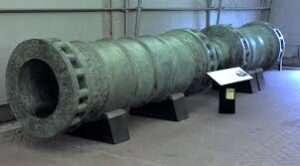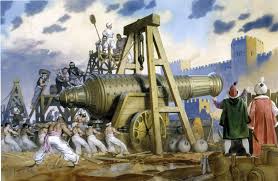Vaša košarica je trenutno prazna!
The fall of Constantinople in 1453 remains one of history’s most defining moments, marking the end of the Byzantine Empire and the dawn of a new Ottoman era. Central to this monumental siege was a technological marvel of its time: Orban’s Great Bombard, widely known as “Orban’s Cannon.” This colossal artillery piece, forged by a brilliant Hungarian master founder named Orban, played an absolutely devastating role in breaching the seemingly impenetrable defenses of Constantinople, forever altering the landscape of warfare and urban siege tactics.

The Genius and Tragic Choice of Orban
The story of Orban’s Cannon begins with its creator, a highly skilled yet ambitious cannon founder. Initially, Orban offered his groundbreaking services to the Byzantine Emperor Constantine XI Palaiologos. However, the financially strapped Byzantines simply couldn’t afford his steep price or provide the immense quantities of materials needed to construct such a monstrous weapon. Frustrated, Orban then turned to the ascendant Ottoman Empire and its ambitious young Sultan, Mehmed II the Conqueror, who eagerly embraced his offer. This fateful decision, a strategic blunder for the Byzantines, sealed Constantinople’s tragic fate.
Under Sultan Mehmed II’s patronage, Orban established his foundry in Edirne, the then-Ottoman capital. Here, utilizing vast amounts of copper, tin, and other metals, he forged his ultimate masterpiece. The cannon was truly immense: historical accounts suggest it was capable of firing a stone ball weighing over 500 kilograms (1,100 pounds). Its sheer size, unprecedented destructive power, and thunderous roar made it a terrifying instrument of war, designed specifically to shatter fortified walls.

Transporting a Titan: An Unprecedented Engineering Feat
Moving Orban’s Great Bombard from Edirne to Constantinople, a distance exceeding 200 kilometers, was an engineering marvel in itself, showcasing Ottoman logistical prowess. It required a massive undertaking involving hundreds of men, dozens of oxen, and specialized carts to haul the colossal weapon across difficult terrain. Bridges had to be specially reinforced, and roads meticulously constructed. This arduous journey took weeks, highlighting the logistical capabilities of the Ottoman army and Mehmed II’s unwavering determination to capture the city.
Upon its arrival at Constantinople’s legendary Theodosian Walls, the cannon was meticulously positioned. Its immense size meant it could only be fired a few times a day, as the gun barrel required considerable cooling after each shot to prevent it from cracking under the immense pressure. Despite this limitation, each successful hit sent shockwaves through the Byzantine defenders, systematically crumbling sections of the ancient fortifications that had withstood countless sieges for over a thousand years. The psychological impact alone was immense.
The Lasting Legacy of Orban’s Cannon: A New Era of Warfare
While Orban’s cannon ultimately burst due to the immense stresses of repeated firing (a common, albeit unfortunate, occurrence for early large-caliber artillery), its impact on the siege was undeniably decisive. It unequivocally demonstrated the overwhelming power of super-heavy artillery in breaching even the strongest medieval fortifications. The dramatic fall of Constantinople served as a stark testament to the rapidly evolving nature of warfare, signaling the irreversible decline of traditional castle and wall defenses and the unstoppable rise of gunpowder technology.
Orban’s creation became a potent symbol of Ottoman military might and innovative spirit, a terrifying precursor to modern artillery. Its fascinating story underscores the critical role of technological advancement and strategic foresight in shaping historical outcomes. The legend of Orban’s cannon continues to captivate, serving as a powerful reminder of how a single, enormous weapon helped rewrite the geopolitical map of the 15th century and irrevocably paved the way for the Ottoman Empire’s significant expansion into Europe.

